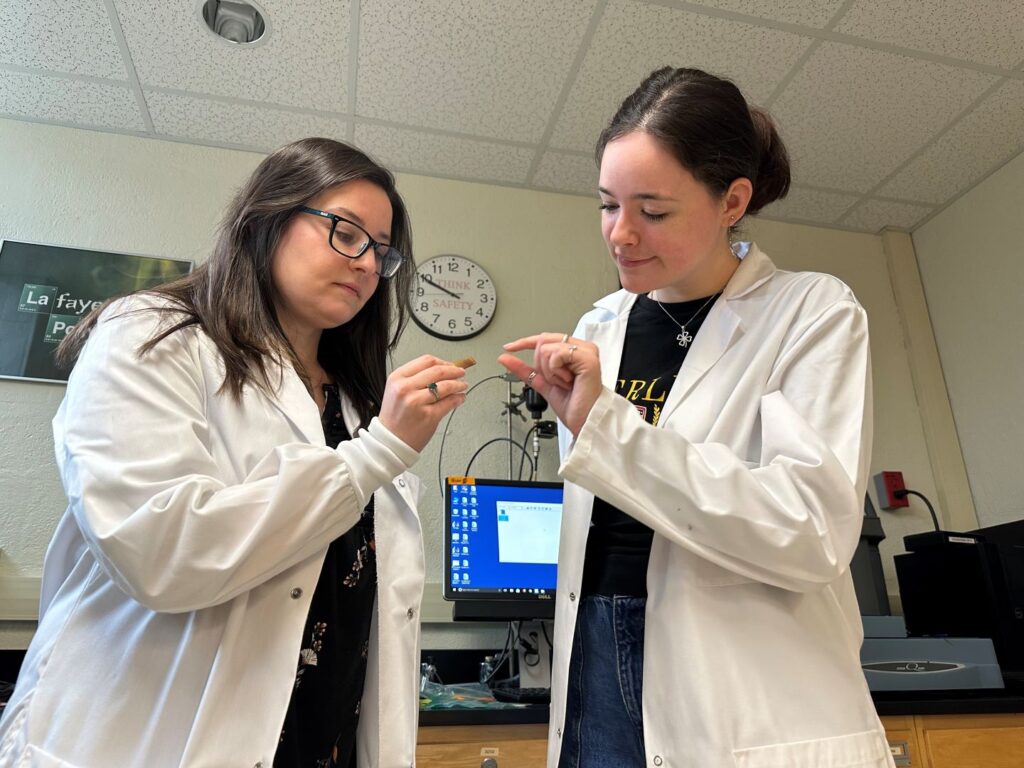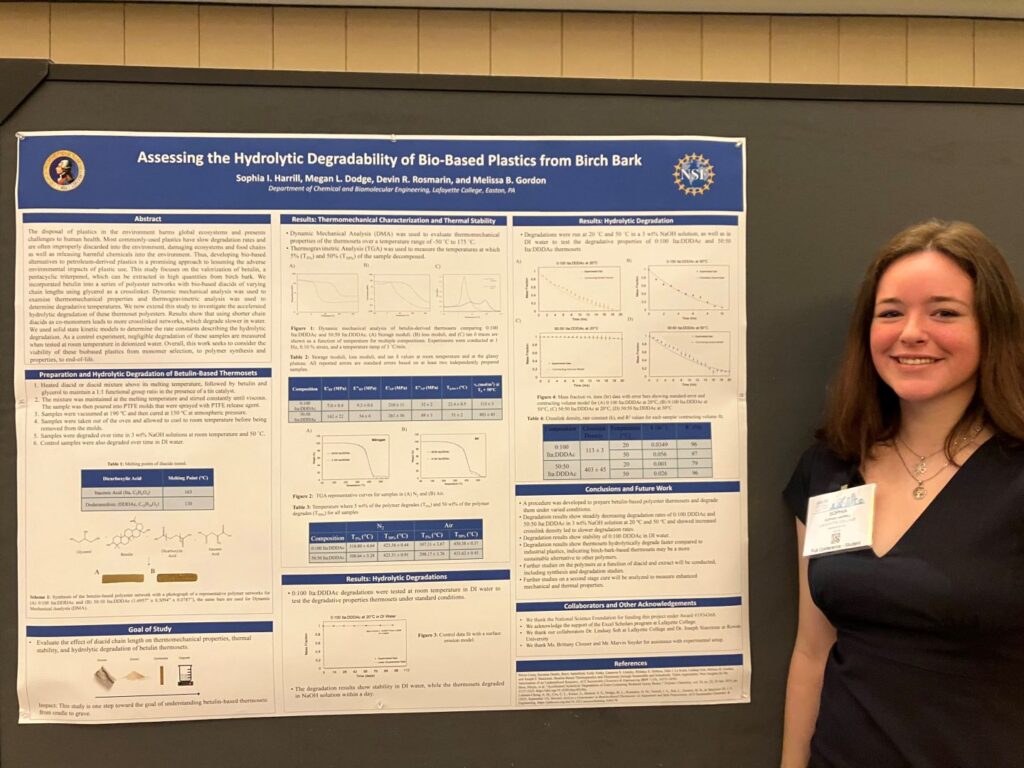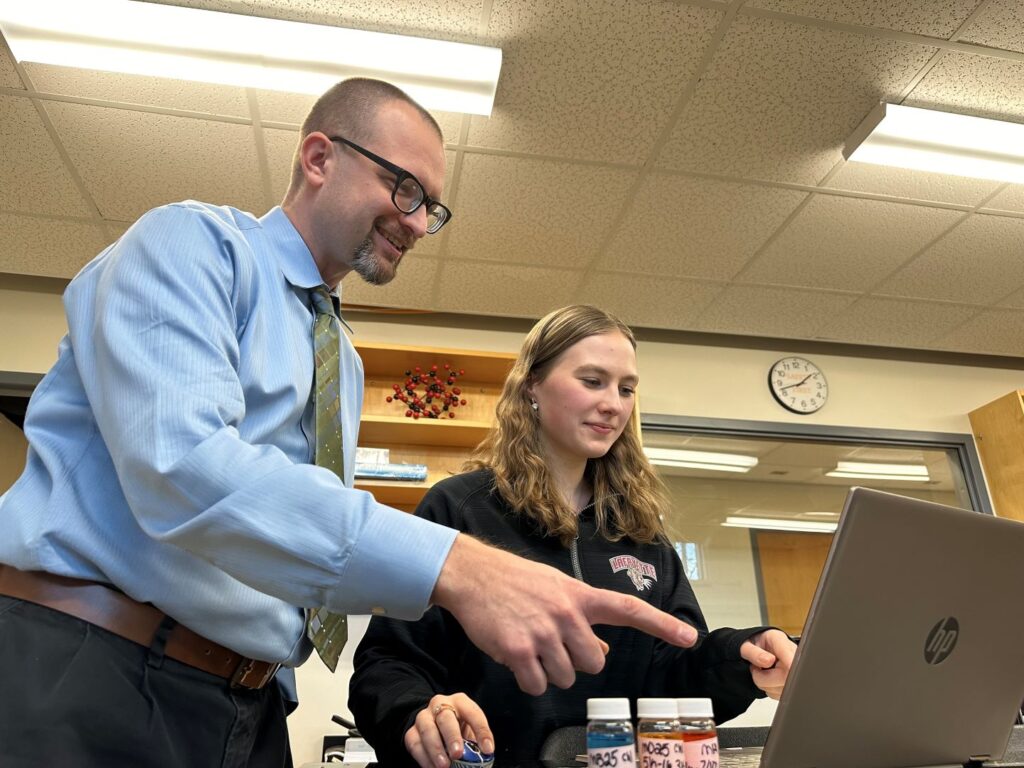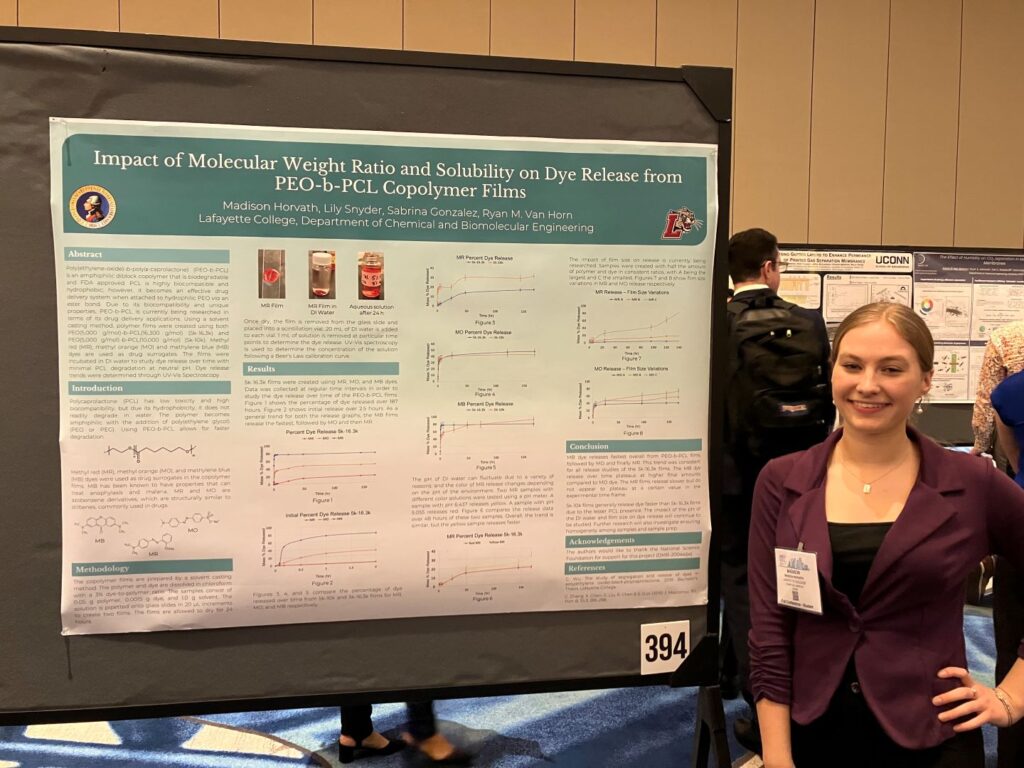Student-faculty research brings national attention to Lafayette’s chemical engineering program
By Bryan Hay
A pair of chemical and biomolecular engineering students working with their professors on cutting-edge research involving polymers recently received national attention for their work.
Competing against hundreds of students from across the country, Sophia Harrill ’26 and Maddy Horvath ’26 won second and third place prizes, respectively, for their poster presentations at the Undergraduate Student Poster Competition held during AIChE’s Annual Student Conference in Orlando, Fla. Facing faculty and graduate students from across the country, students are meticulously evaluated on the quality of their posters and research as well as on their presentation skills and ability to answer technical questions on the spot.
Harrill is working alongside Melissa Gordon ’11, associate professor of chemical and biomolecular engineering, on using betulin, a compound found in birch bark, to create biobased plastics.

Prof. Melissa Gordon ’11 and Sophia Harrill ’26
“What we’re doing with our research is seeing if we actually can create a green polymer,” Harrill says. “We test its mechanical properties, to see how they compare with more industrial plastics. We’re also working on degradations with these plastics and seeing how different chain links that we use in synthesizing the compound can influence properties. Basically, we’re seeing if our product degrades faster than more industrial plastics. It’s a really big environmental issue.”
Harrill considers herself fortunate that Gordon accepted her as a first-year student, with little experience, to assist in such a significant research project. Last year, Gordon received a five-year $600,000 National Science Foundation Faculty Early Career Development Program award, the agency’s most prestigious recognition of early-career faculty, to support her research in force-responsive synthetic polymeric materials.
“I wanted to go into chemical engineering to work in plastics, specifically in biodegradable plastic,” Harrill says. “And it just so happened that I came to Lafayette and found a lab that was doing exactly what I wanted to do. Our research is really interesting. And I think that translates into how all of us feel in the lab. We’re all very interested in what we’re doing. And we know that our work could potentially have positive real-world applications.”
Lafayette, she says, allows her to grow independently as a researcher.
“A lot of undergraduates at other institutions are always shadowing someone,” Harrill says. “The really nice thing about Lafayette is that the students here have resources just for undergrads. Your professors are really working with you and focusing on making sure you have the skills to do the research on your own. It’s great, because we’re working with professors who are so good at what they do that you’re learning from them directly.”
She learned about her second-place award at the conference while waiting with other Lafayette students in a long line at the airport on her way home.
“I called Prof. Gordon to tell her that we might miss our flight. And she said, ‘Guess what? You and Maddy won awards,’” Harrill recalls. “I was shocked. For starters, it was because we competed against much older undergraduate students with more research time under their belts. Everyone seemed so smart, and that was a little bit intimidating. I was definitely surprised but very happy to have Ph.D. students and faculty from other institutions recognize the value of our research.”

Sophia Harrill ’26
In addition to her academic pursuits, Harrill is a member of the Lafayette Outdoors Society, Lafayette Happiness Project, and Lafayette for Reproductive Autonomy, Justice, and Empowerment club. She’s still considering what path to take after Lafayette, either grad school or going straight into industry. With an internship lined up at Air Products next summer, Harrill hopes to get into its research and development lab to see what research looks like in an industrial setting.
Gordon says Harrill has “incredible potential for research.”
“She clearly stood out at the poster session,” Gordon says, noting that faculty and graduate students remarked to her on the quality and professionalism of Harrill’s poster presentation.
“She is very meticulous in every detail. She always comes in with a plan with what she wants to do,” Gordon says. “Even when there are setbacks, which inevitably happen, she comes in with a plan outlining what she’s going to do to remediate it and identifying the next steps. She’s really taken ownership of the project.”
Gordon is grateful for the continued support of her work from Meg Dodge ’23, now a chemical engineering doctoral student at Oregon State University, who helped train Harrill so she could take over her lab work at Lafayette and continues to stay involved in the project to this day. This work is supported by a collaborative NSF grant with Prof. Lindsay Soh, who uses green techniques to extract betulin from birch bark.
“I think it really boils down to the environment we have in the lab. We’re all friends, and Prof. Gordon is a great mentor,” Harrill observes. “It is really encouraging when you’re working with students and alumni who support you. Research is not always the easiest thing to do. You have unanticipated setbacks that you have to work through and resolve. So, it’s great when you’re just working with people who are supportive and collaborative. I don’t think I would have gotten that somewhere else.”
Maddy Horvath and Prof. Ryan Van Horn
Horvath is working with Ryan Van Horn ’04, associate professor of chemical and biomolecular engineering, on a polymer drug delivery project.
“Let’s think about cancer drugs, which are incredibly hydrophobic,” she says. “To have a good drug delivery system to get that drug to the tumor, it’s really hard to have a hydrophobic system because there’s so much water in the body.”
She and Van Horn work with an amphiphilic polymer, which has a hydrophilic and hydrophobic component.
“It’s biodegradable, FDA approved, and biocompatible with the human body,” Horvath says. “It means that it’s really good in these drug delivery applications. And we’re looking at it in terms of a slow, sustained drug release for a tumor over time. So, my research specifically focuses on the drug release rates of the polymer using dyes incubated in deionized water. I can calculate the concentration and release over time, looking at the solubility of the different dyes over time.”
Attracted to chemical engineering since high school, after an internship at Regeneron Pharmaceuticals Inc., Horvath is also interested in the environment and sustainability and continues to enjoy her biomedical work in Van Horn’s lab.

Prof. Ryan Van Horn ’04 and Maddy Horvath ’26
“I just really enjoy the project. I find it really interesting,” she says. “And I really enjoy working with Prof. Van Horn and being in the lab environment. That’s just made it a really enjoyable project overall.”
As an Engineering Division tour guide for prospective students and their families, she eagerly shares her Lafayette experiences as part of her presentation.
“I always tell my tour groups that one of the main reasons I came to Lafayette was for the research opportunities,” Horvath says. “Prof. Van Horn was my First-Year Seminar professor, and I just talked to him one day and he invited me to be in his lab. Being at Lafayette, where you can work under professors so closely, you’re really hands-on in a project, and you get a real in-depth intellectual experience with your research.”
She credits Lafayette’s tradition of student-faculty research partnerships as a reason why she performed so well at the poster competition.
“It’s why Lafayette students do so well,” Horvath says. “You can really talk intelligently about your research, because you’re passionate about it. It’s not like being at a big institution, where you’re working under a graduate student, and you’re just kind of being told what to do. Here you’re in the lab on your own, going through literature, figuring out what you want to do, communicating with the professor who you work for about what you want to do, and troubleshooting and asking questions. All of this really fosters an in-depth understanding of your project.”
Like Harrill, she was shocked when she learned about her poster presentation award.
“Honestly, I wasn’t going to the conference with any intention of winning,” Horvath says. “I was just going for the experience of presenting a research poster and for the networking opportunities.”

Maddy Horvath ’26
Van Horn recalls the moment when Horvath approached him about research opportunities during his FYS.
“I knew Maddy was interested in chemical engineering,” he says. “But when she asked about research, I expected questions like how do I get into it? And what do I do? I said, you talk to professors or look at their websites to see the kind of work they do. She asked me about my personal research, because the FYS is about plastic. I told her about what we do and that I design my research to be as accessible as possible for students of varying levels. She wanted to be in my lab the next day. She showed a genuine passion in wanting to help with this research.”
Horvath stayed at Lafayette over her first summer to work in the lab and developed independence, Van Horn says.
“She just really took off and wanted to learn more and wanted to do more than stay for the summer,” he adds. “And at that point, it was really easy for her to make enough progress to put a poster together. My approach is to be supportive and let students be independent. Maddy put the poster together on her own and asked for feedback. I helped her edit it, but I didn’t do anything in terms of putting it together or making it. To demonstrate that she’s at or above the level of all of these other undergraduate students is just awesome. For her to win an award, it’s just even more a demonstration of her abilities and her knowledge.”
In addition to her academics, Horvath serves as secretary with Lafayette’s chapter of the Society of Women Engineers, the sophomore representative to the American Institute of Chemical Engineers, and the student representative to the Board of Trustees on educational policy, and is a member of Stress Less, a campus yoga and meditation club, and the Lafayette Happiness Project.
“I’m so happy to be in this lab. And I’m so happy to have the support of Prof. Van Horn and the support of my lab mates,” she says. “We have such a great group of students in this lab. I couldn’t have done it without them.”

